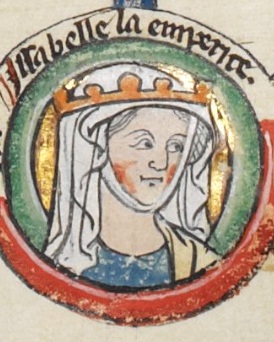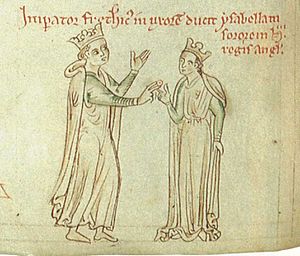Isabella of England facts for kids
Quick facts for kids Isabella of England |
|
|---|---|
 |
|
| Holy Roman Empress Queen consort of Germany and Sicily |
|
| Tenure | 15 July 1235 – 1 December 1241 |
| Born | 1214 Gloucester, England |
| Died | 1 December 1241 (aged 26–27) Foggia, Apulia, Italy |
| Burial | Andria Cathedral, Italy |
| Spouse | Frederick II, Holy Roman Emperor |
| Issue | Margaret, Landgravine of Thuringia |
| House | Plantagenet |
| Father | John, King of England |
| Mother | Isabella, Countess of Angoulême |
Isabella of England (1214 – 1 December 1241) was an English princess from the House of Plantagenet family. She became the Holy Roman Empress and Queen of Sicily and Germany from 1235 until her death. She was the third wife of Emperor Frederick II.
Contents
Isabella's Early Life
When and Where Was Isabella Born?
Isabella was born around 1214. She was the fourth child and second daughter of King John of England and his second wife, Isabella of Angoulême. We don't know her exact birthday. Historians guess her birth year because she married at age 21.
Isabella's parents' marriage was already having problems when she was born. She spent most of her early years with her mother. After King John died in 1216, Isabella stayed with her mother. In 1220, her mother remarried and left the English court.
Who Raised Princess Isabella?
Princess Isabella was raised by her nurse and governess, Margaret Biset. Margaret was paid one penny a day for her work. This payment was ordered by Isabella's brother, King Henry III. Margaret stayed with Isabella and even went with her to Germany when Isabella got married.
King Henry III also paid for Isabella's other servants. These included her cook and stableman. If any of Isabella's servants retired, they received a good pension.
Isabella spent her first years at Gloucester Castle. Later, when things settled down in her brother's early reign, she moved to the royal court. The court was first in Woodstock and then in Westminster. Isabella and her family also visited other royal homes. These included Winchester, Marlborough, and York.
Isabella's Teenage Years
In 1220 or 1221, Isabella's older sister, Joan, was set to marry King Alexander II of Scotland. Their marriage contract said that if Joan didn't return to England by September 29, King Alexander would marry Isabella instead.
Over the next ten years, King Henry III tried to arrange marriages for Isabella twice. First, in 1225, there were talks about her marrying King Henry (VII) of Germany. He later became Isabella's stepson. Then, there were talks about her marrying King Louis IX of France.
As Isabella grew older, she preferred to be private. In November 1229, she moved to Marlborough Castle with her brother's permission. This castle became her home. King Henry III made sure she could choose any rooms she wanted there.
Isabella and her brother had a very close relationship. The King visited her several times. He visited Marlborough for the wedding of one of Isabella's servants. He also visited her in 1231 and 1232 at Gloucester Castle.
In November 1232, King Henry III sent his personal tailor to Isabella. He wanted her to have a new wardrobe of clothes. The King also celebrated Christmas with Isabella that year. He sent her the best dishes from his own table and gave her many gifts. For months after, he sent her items for her own chapel.
Isabella and her guests received food from men in Gloucester. The King regularly sent her wine and venison. He also let her use one of his fish suppliers. The royal chaplain, Warin, who served Isabella, was also given to her by the King. In the summer of 1232, Isabella returned to Marlborough Castle.
Isabella's Royal Marriage
In 1234, Isabella left her quiet life and moved to the Tower of London. In November, Emperor Frederick II, who had been married twice before, was advised by Pope Gregory IX to ask for Isabella's hand. In February 1235, he sent a group of important people to King Henry III. This group was led by his chancellor, Pietro della Vigna.
The marriage between Isabella and Emperor Frederick II was meant to make England and the Holy Roman Empire stronger allies. This alliance would stand against France. After three days of talks, King Henry III agreed to the marriage. Isabella was brought from the Tower to the Palace of Westminster. There, she met the Emperor's representatives. They said she was "the most worthy of the imperial brides." They placed a wedding ring on her finger and greeted her as their Empress.
The Marriage Contract
On February 22, 1235, an agreement was signed. King Henry III would give his sister a dowry of 30,000 marks. This money was needed by the Emperor to pay for his wars in northern Italy. The dowry was to be paid within two years. As a wedding gift, the King gave Isabella many necessary items. These included jewelry, horses, and rich clothes, all made in the latest German style. The princess also received official letters from the Emperor. These letters gave Isabella, as Queen of Sicily and Holy Roman Empress, ownership of lands due to her.
On February 27, both sides signed the marriage contract. The marriage of the English princess to the Holy Roman Emperor was exciting for King Henry III and for the common people. However, the people were upset by the large "help" (tax) they had to pay. The King had to collect a tax of two marks of silver per hide of land to afford Isabella's dowry.
Journey to Germany
In early May 1235, Archbishop Heinrich I of Cologne and Duke Henry I of Brabant arrived in England. They came to take the bride to her new home. Isabella left London on May 7. She was cared for by the Bishop of Exeter, William Briwere. Isabella's brothers went with her from Canterbury to Sandwich. From there, Isabella sailed on May 11. Four days later, they landed in Antwerp.
Before Isabella left England, the Emperor's representatives promised King Henry III something important. If the Emperor died before the marriage, Isabella would return home safely. There were rumors that the Emperor's enemies, who were allied with the French king, tried to kidnap Isabella on the way. But the guards sent by Emperor Frederick II protected the princess. On May 22 or 24, Isabella arrived in Cologne. She stayed at the house of a church leader. She had to wait there for six weeks because the Emperor was fighting a war with his own son.
Life as Empress
After waiting six weeks, Emperor Frederick II called his bride to Worms. Their official wedding took place there. Isabella was crowned at Worms Cathedral by Archbishop Siegfried III of Mainz. Historians disagree on the exact date of this event. Some say July 20, 1235, while others say Sunday, July 15.
The wedding celebrations lasted for four days. It is said that "four kings, eleven dukes, counts and margraves, thirty or fewer prelates and minor nobles" attended. On August 14, Emperor Frederick II held a meeting. Representatives from all over the Empire were invited. They met the new empress and congratulated her.
Isabella (sometimes called Elizabeth by her husband's people) was seen as a very graceful and beautiful woman. Frederick was very happy with his new wife. However, right after the wedding, he sent away all of Isabella's English helpers, both men and women. He only kept her nurse, Margaret Biset, and one maid. He then moved her to a quiet place in Haguenau, where they spent most of the winter. Before this, the English group who came with Isabella returned home. They brought gifts to their king from the emperor, including three live leopards. Leopards were on the English king's coat of arms.
Soon after the wedding, Emperor Frederick II had to leave. He left his wife in the care of his son, Conrad. In early 1236, Isabella and her husband visited Ravenna. The imperial couple spent part of the year in Italy, then returned to Germany.
Even after marrying, Isabella stayed in touch with her brother, King Henry III. They wrote letters to each other regularly. Their letters were warm, as much as royal rules allowed. The Emperor himself also wrote warm letters to the English king. But his wife's name was mentioned only sometimes, and only for political reasons. In July, Emperor Frederick II prepared for a military campaign. He had to leave his wife in Germany for almost a year.
By Michael's Day (September 29), Emperor Frederick II returned to Lombardy. He called his wife to join him there, and they spent the winter together. In September 1238, the emperor sent his wife to Andria. Isabella stayed there until December. Then, the archbishop of Palermo took her back to Lombardy. In early 1239, Isabella spent some time in Noventa Padovana while her husband was in Padua. In February 1240, she returned to southern Italy, where the emperor soon arrived.
Emperor Frederick II seemed to respect and love his wife. However, he kept her somewhat apart from others. He made sure she was safe and lived in luxury. But she was kept away from him and his "harem" (a group of other women in his court). Isabella's brother, King Henry III, complained that his sister was never allowed to wear her crown in public. She also couldn't appear as empress at public meetings. In 1241, her second brother, Richard of Cornwall, visited Frederick on his way back from the Holy Land. It took "a few days" before he was allowed to visit his sister's rooms. Frederick did not let Isabella meet her brother at court.
Isabella died during childbirth in Foggia, near Naples, in 1241. Historians say she died between December 1 and 6. Frederick II was in Faenza when his wife died. Isabella's last words were a request to her husband. She asked him to stay friends with her brother, King Henry III. Isabella was buried with full honors at Andria Cathedral near Bari. She was buried next to Frederick's previous wife, Queen Isabella II of Jerusalem.
King Henry III was very sad and shocked by his sister's death. He ordered his almoner (a person who gives money to the poor) to give over £200 in charity. This was done "for the soul of the empress, our late sister," in Oxford and Ospringe. The same amount was given in London and Windsor. Matthew Paris, a historian, was sad about Isabella's death. He called her "the glory and hope of England."
Isabella's Children
Historians have different ideas about how many children Isabella had and their names. Here are the most commonly accepted children:
- Margaret (born February 1237 – died 1270). She married Albert II, Margrave of Meissen.
- Henry (born February 18, 1238 – died 1253 or 1254). After his father died, he became the King of Jerusalem in name.
- A child who died during childbirth in December 1241. This child is often thought to be Margaret.
See also
 In Spanish: Isabel de Inglaterra (1214-1241) para niños
In Spanish: Isabel de Inglaterra (1214-1241) para niños


